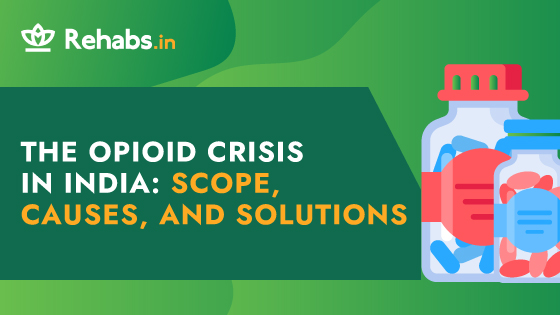The Opioid Crisis in India: Scope, Causes, and Solutions

Opioids are a class of powerful drugs that are primarily used for pain relief. They work by binding to opioid receptors in the brain, spinal cord, and other areas of the body to reduce the perception of pain. While opioids can be highly effective in managing severe pain, they also carry a high risk of addiction and misuse. Common opioids include prescription medications like oxycodone, hydrocodone, and morphine, as well as illegal drugs like heroin.
This blog will delve into the factors that contribute to opioid use and addiction, explore the various causes of addiction, analyse the healthcare impact and propose solutions and interventions to address these challenges.
Overview of the Opioid Crisis
Opioid addiction in India has become a significant public health concern, with a notable rise in recent years. Approximately 2.1% of India’s population, which translates to about 2.26 crore individuals, are users of opioids. This category of opioids encompasses substances such as opium and its derivatives like poppy husk, known as doda/phukki, as well as heroin and its impure forms like smack or brown sugar.
Pharmaceutical opioids are also included in this statistic, highlighting the widespread nature of opioid use across various segments of the population in India. The problem is particularly acute in states like Punjab, Uttar Pradesh, and Maharashtra, where opioid abuse rates are among the highest in the country.
Studies have shown that the availability of opioids, both through prescription medications and illicit sources like heroin, plays a critical role in fueling addiction rates. The lack of adequate awareness, the stigma surrounding addiction, and limited access to effective treatment services contribute to the persistence of this crisis.
Research also highlights the devastating impact of opioid addiction on individuals, families, and the healthcare system in India. A study published in the Indian Journal of Psychiatry found that opioid dependence not only leads to severe health consequences such as respiratory depression, infections, and mental health disorders but also places a significant burden on healthcare resources.
The costs associated with treating opioid-related complications, including hospitalisations, medications, and rehabilitation programs, contribute to the strain on already stretched healthcare services. Additionally, the societal costs in terms of lost productivity, social disruption, and increased crime related to opioid addiction further underscore the urgent need for comprehensive interventions and strategies to address this growing epidemic.
Causes of the Opioid Crisis
Causes of opioid addiction can be multifaceted and involve various factors, including pharmaceutical influences, prescription practices, and socioeconomic conditions. Here are some key causes:
Pharmaceutical Factors:
- Chemical Properties: Opioids are highly effective in relieving pain, which can lead to their overuse or misuse by individuals seeking relief.
- Addictive Potential: Opioids can produce feelings of euphoria and relaxation, making them psychologically addictive.
- Marketing Practices: Aggressive marketing by pharmaceutical companies in the past may have contributed to increased prescribing rates and subsequent addiction.
Prescription Practices:
- Over-prescribing: Healthcare providers may overprescribe opioids for pain management, leading to unnecessary exposure and potential addiction.
- Lack of Monitoring: Inadequate monitoring of patients’ opioid use and insufficient follow-up assessments can contribute to misuse and addiction.
- Patient Expectations: Patient demand for quick pain relief and a lack of awareness about alternative pain management strategies can influence prescription practices.
Socio-Economic Factors:
- Poverty and Unemployment: Socioeconomic disparities, including poverty and unemployment, can increase the likelihood of opioid use as a coping mechanism.
- Trauma and Stress: Individuals experiencing trauma, chronic stress, or mental health issues may turn to opioids as a way to self-medicate and alleviate distress.
- Accessibility and Availability: Easy access to opioids, whether through legal prescriptions or illicit markets, can contribute to higher rates of addiction in certain communities.
Cultural Norms and Peer Influence:
- Normalisation of Use: Cultural attitudes that normalise opioid use or downplay the risks associated with addiction can contribute to its prevalence.
- Peer Pressure: Influence from friends, family members, or social circles where opioid use is common can increase the likelihood of experimentation and subsequent addiction.
The opioid epidemic in the USA, UK, and Canada is primarily linked to prescription opioids, while in India and several other Asian countries like Pakistan, Afghanistan, and Iran, the epidemic is predominantly driven by heroin addiction, with pharmaceutical opioids sourced from the informal drug market without prescriptions even among people who inject drugs (PWIDs).
Socio-economic disparities, coupled with cultural norms that may normalise opioid use or provide inadequate education about its risks, created environments where individuals facing trauma, stress, or chronic pain turned to opioids as a coping mechanism. This combination of factors created a perfect storm, fueling addiction rates and ultimately resulting in the devastating opioid crisis in India, characterised by widespread addiction, overdose deaths, strained healthcare resources, and societal impacts.
Addressing this crisis requires a multifaceted approach that encompasses improved prescribing practices, enhanced education, access to alternative pain management options, targeted interventions in high-risk communities, and comprehensive support for individuals struggling with addiction.
Impact on Society
The opioid crisis has had significant effects on the healthcare system in India, straining resources and presenting complex challenges for healthcare providers. One major impact is the increased demand for addiction treatment services and resources. Hospitals and healthcare facilities are overwhelmed with patients seeking help for opioid addiction, leading to longer wait times, overcrowded treatment centres, and difficulties in providing comprehensive care.
The financial burden on the healthcare system has escalated due to the costs associated with treating opioid-related complications, such as overdose cases, infections, and mental health disorders. These costs extend beyond immediate medical care to include rehabilitation programs, counselling services, and ongoing support for individuals in recovery.
Apart from its impact on the healthcare system, opioid addiction has wide-ranging social and economic implications in India. Socially, it can lead to family disruption, strained relationships, and stigmatisation of individuals with addiction. Communities may also experience increased crime rates and social instability related to drug trafficking and illicit drug use. Economically, opioid addiction can result in lost productivity due to absenteeism, decreased workforce participation, and reduced earning potential for individuals struggling with addiction.
The financial burden extends to families and society at large as they cope with the costs of addiction treatment, legal issues, and the long-term consequences of opioid misuse on overall well-being and quality of life. Addressing these social and economic challenges requires coordinated efforts across healthcare, social services, law enforcement, and community support systems to mitigate the impact of opioid addiction on individuals and society as a whole.
Solutions and Interventions
In India, several government policies and regulations are in place to control the distribution of opioids and mitigate the risks associated with their misuse. Some key policies and regulations include:
- Narcotic Drugs and Psychotropic Substances Act (NDPS Act), 1985: This comprehensive legislation regulates the production, manufacture, possession, sale, purchase, transport, warehousing, use, consumption, import, inter-State, export, and transhipment of narcotic drugs and psychotropic substances. It also establishes stringent penalties for offences related to the misuse of opioids and other controlled substances.
- Narcotics Control Bureau (NCB): The NCB is the nodal agency responsible for coordinating drug law enforcement activities, intelligence gathering, and international cooperation to combat drug trafficking and misuse. It works closely with state law enforcement agencies and other stakeholders to enforce the provisions of the NDPS Act.
- Controlled Substances Regulations: The Central Drugs Standard Control Organization (CDSCO) oversees the regulation of controlled substances, including opioids, through the issuance of licenses, permits, and guidelines for their manufacture, distribution, and sale. Strict monitoring and auditing mechanisms are in place to ensure compliance with regulations and drug abuse prevention.
- Opioid Availability Monitoring Systems: The government has established systems to monitor the availability, prescribing patterns, and consumption of opioids across healthcare facilities. This includes the use of electronic databases, prescription monitoring programs, and reporting mechanisms to track opioid distribution and identify potential areas of concern.
- Guidelines for Opioid Prescription: The Ministry of Health and Family Welfare has issued guidelines and protocols for healthcare providers regarding the appropriate prescribing practices for opioids. These guidelines emphasise the importance of risk assessment, patient education, informed consent, dose monitoring, and referral to specialised services for pain management and addiction treatment.
- Public Awareness Campaigns: The government, along with healthcare organisations and non-governmental agencies, conducts public awareness campaigns to educate the public, healthcare professionals, and law enforcement personnel about the risks of opioid misuse, addiction signs, and available support services.
There are several community-based initiatives and rehabilitation programs aimed at addressing opioid addiction and supporting individuals in recovery. Narcotics Anonymous (NA) and Alcoholics Anonymous (AA) Groups play a crucial role in supporting individuals recovering from opioid addiction across India. These peer-led support groups create safe environments where individuals can openly share their experiences, receive encouragement, and engage in the 12-step recovery program. NA and AA meetings are regularly held in various communities, ensuring accessibility for individuals in need of ongoing support during their journey to recovery.
There are numerous rehabilitation centres across India dedicated to treating opioid addiction. Here are a few notable examples:
Calida Rehabilitation Centre: Nestled in a picturesque setting near Karjat, conveniently accessible from Mumbai and Pune, Calida offers a serene environment away from the hustle and bustle of city life. Calida’s approach emphasises personalised treatment protocols tailored to each individual’s unique needs, fostering inner healing and recovery.
Alpha Healing Center: Recognized with ISO certification, Alpha Healing Center delivers comprehensive medical and psychiatric care for individuals grappling with opioid addiction. The centre’s focus extends beyond breaking addiction’s chains to nurturing holistic well-being, addressing physical, mental, and emotional aspects of recovery.
Jagruti Rehab Center: Specializing in addiction and behavioural disorders, Jagruti Rehab Center in Mumbai provides a comprehensive treatment approach. Their services include specialised treatments, psychological re-programming, intensive rehabilitation programs, and ongoing support, empowering individuals to overcome addiction and achieve lasting recovery.
There are treatment centres in various parts of the world, including India that offer free or low-cost treatment options for individuals struggling with substance use disorders, including opioid addiction. The importance of seeking treatment for opioid addiction cannot be overstated, as it can significantly improve quality of life, reduce health risks, prevent overdose deaths, and help individuals regain control over their lives. These treatment centres not only provide medical interventions such as detoxification and medication-assisted treatment but also offer counselling, therapy, education, and support to address the underlying issues contributing to addiction and promote long-term recovery.
Sources:
Dydyk AM, Jain NK, Gupta M. Opioid Use Disorder. [Updated 2024 Jan 17]. In: StatPearls [Internet]. Treasure Island (FL): StatPearls Publishing; 2024 Jan-. Available from: https://www.ncbi.nlm.nih.gov/books/NBK553166/
National Drug Dependence Treatment Center [NDDTC] & All India Institute of Medical Sciences [AIIMS]. (2019). Magnitude of Substance Use in India. Ministry of Social Justice and Empowerment. https://socialjustice.gov.in/writereaddata/UploadFile/Survey%20Report.pdf
Risk and protective Factors | Youth.gov. (n.d.). https://youth.gov/youth-topics/risk-and-protective-factors
Singh, B., & Rao, R. (2021). Is there an opioid epidemic in India? Journal of Public Health, 43(Supplement_2), ii43–ii50. https://doi.org/10.1093/pubmed/fdab322














